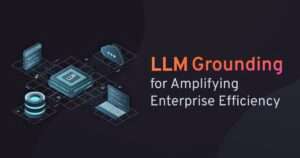An Introduction to Grounding LLMs
In the constantly evolving artificial intelligence technology, Large Language Models (LLMs) stand out as pillars of innovation, driving efficiency and productivity across various industries.
Among many strategies aimed at harnessing the potential of language models, LLM grounding emerges as a pivotal concept, designed to significantly enhance the capabilities of these models by embedding industry-specific knowledge and data.
This article delves into the essence of LLM grounding, unraveling its importance, methodologies, challenges, and applications, particularly through the lens of Retrieval-Augmented Generation (RAG) and fine-tuning LLMs with entity-based data products.
What is LLM grounding?
LLM grounding is the process of enriching large language models with domain-specific information, enabling them to understand and produce responses that are not only accurate but also contextually relevant to specific industries or organizational needs.
By integrating bespoke datasets and knowledge bases, domain-specific LLM is trained to navigate through the nuances of specialized terminologies and concepts, thereby elevating their performance to meet enterprise-specific requirements.
During their initial training phase, base language models (LLMs) are exposed to a diverse and extensive dataset, predominantly derived from the internet. This process is akin to an all-encompassing curriculum, designed to teach LLMs a broad spectrum of information.
However, even with such comprehensive training, these models frequently encounter difficulties in understanding the specific nuances, such as industry and organization-specific details and reasoning. Furthermore, they often struggle with organization-specific jargon, primarily because they have not been exposed to these details beforehand.
This is where the concept of grounding plays a critical role, transforming an otherwise basic premise into a strategic advantage. Grounding an LLM involves enriching the base language model with highly relevant and specific knowledge or data to ensure it maintains context.
This process enables LLM grounding to access and illuminate previously overlooked content, thereby revealing unique aspects of a particular industry or organization.
In simpler terms, grounding in LLMs serves as an enhancement to the machine learning process of these base language models. It acquaints them with the distinctive aspects of an industry or organization that might not have been included in their original training dataset.

Why LLM Grounding is Important
The significance of LLM grounding in enhancing the capabilities of AI within enterprises cannot be overstated. This LLM strategy brings about several key benefits, directly addressing some of the core challenges associated with deploying generative AI technologies in specialized environments.
Countering AI Hallucination: One of the foremost advantages of grounding in LLM is its role in mitigating “AI Hallucination” a phenomenon where base language models generate misleading or factually incorrect responses due to flawed training data or misinterpretation. Grounding equips models with a solid, context-aware foundation, significantly reducing instances of inaccurate LLM outputs and ensuring that the AI’s responses are reliable and aligned with reality.
Enhancing Comprehension: Grounded LLMs exhibit a superior ability to grasp complex topics and the subtle nuances of language that are unique to specific industries or organizations. This improved understanding allows AI models not only to interact but also to guide users more effectively through complex inquiries, diminishing confusion and clarifying intricate issues.
Improving Precision and Efficacy: By incorporating industry-specific knowledge, LLM grounding ensures that AI models can provide more accurate and relevant solutions swiftly, thus effectively responding to user queries. This precision stems from a deep understanding of the unique challenges and contexts within specific sectors, enhancing the overall efficiency of operations.
Accelerating Problem-Solving: Another critical benefit of LLM grounding is its impact on problem-solving speeds. Grounded models, with their enriched knowledge base and understanding, are adept at quickly identifying and addressing complex issues, thereby reducing resolution times. This capability not only improves operational efficiency but can also lead to exponential gains by streamlining problem-resolution processes across the enterprise.
In essence, LLM grounding is pivotal for leveraging the full potential of AI technologies in specialized applications. By enhancing accuracy, understanding, and efficiency, LLM grounding addresses critical gaps in AI deployment, making it an indispensable strategy for businesses aiming to harness the power of artificial intelligence effectively. Now, let’s delve into how it is implemented to achieve these significant benefits.
How Does LLM Grounding Work?
LLM grounding revolutionizes how Large Language Models (LLMs) understand and interact within specific enterprise contexts by infusing them with a rich layer of domain-specific knowledge. This process involves several meticulously designed stages, each contributing to a more nuanced, accurate, and effective AI model. Here, we break down the intricacies of how LLM grounding is executed:
1. Grounding with Lexical Specificity
This foundational step involves tailoring the LLM to the specific lexical and conceptual framework of an enterprise. By exposing the model to data unique to the organization’s context and operational environment, it gains a profound understanding of the enterprise-specific language and terminology. Such data sources include:
- Enterprise-grade ontologies: Structures that encapsulate the enterprise’s lexicon, terms, and their interrelations, offering the LLM a comprehensive insight into the organizational language.
- Service Desk Tickets: These provide a wealth of problem-solving instances and solutions that enrich the model’s practical understanding of common issues within the enterprise.
- Conversation Logs and Call Transcripts: Real-world communication samples that enhance the model’s grasp of conversational nuances and enterprise-specific language patterns.
2. Grounding with Unexplored Data
To address and mitigate the biases inherent in pre-training phases, LLM grounding extends to incorporate new and diverse datasets that were not part of the initial model training. This includes:
- Industry-Specific Public Resources: Such as blogs, forums, and research documents, which introduce the model to broader perspectives and insights across various sectors.
- Enterprise-Exclusive Content: Proprietary documents, training materials, and backend system data that provide unique, company-specific knowledge.
3. Grounding with Multi-Content-Type Data
LLM grounding also entails teaching the model to interpret and process information across a myriad of formats, from text to multimedia. Understanding these diverse relevant data types is crucial for tasks like:
- Content Comprehension: Grasping the hierarchical structure and relational context of information.
- Information Extraction: Identifying and extracting relevant details from complex datasets.
- Content Summarization: Condensing information based on structural significance, such as document headers or key spreadsheet columns.
Table: Stages of LLM grounding
|
Stage |
Description |
| Grounding with Lexical Specificity | Tailors the LLM to organizational lexicon and concepts, utilizing ontologies, service tickets, and communication logs. |
| Grounding with Unexplored Data | Broadens the LLM’s knowledge base with industry-specific public resources and proprietary enterprise content, addressing pre-training biases. |
| Grounding with Multi-Content-Type Data | Enhances the LLM’s ability to process and interpret various data formats, improving content comprehension, information extraction, and summarization capabilities. |
Through these stages, LLM grounding transforms base language models into highly specialized tools capable of navigating the unique linguistic and operational landscapes of specific enterprises.
By integrating a diverse range of data sources and content types, LLM grounding ensures that AI models can deliver precise, contextually relevant, and effective responses, marking a significant leap in AI’s practical application in business contexts.
LLM Grounding Technique with RAG
Retrieval-Augmented Generation (RAG) and agentic RAG systems offer a sophisticated approach to LLM grounding by dynamically incorporating external data during the response generation process. This method enables LLMs to pull in the most relevant information from a vast database at runtime, ensuring that the responses are not only contextually appropriate but also up-to-date.
The integration of RAG into LLM grounding significantly enhances the model’s ability to handle complex queries across various domains, providing answers that are informed by the latest available data. However, implementing RAG presents challenges, including the need for efficient data retrieval systems and the management of data relevance and accuracy.
Despite these hurdles, RAG remains a promising avenue for elevating LLM performance, particularly in scenarios requiring real-time access to expansive knowledge bases.
Thus, RAG significantly amplifies LLM grounding’s effectiveness, paving the way for a discussion on another innovative application: entity-based data products.
LLM Grounding Technique Using Entity-Based Data Products
Grounding LLMs using entity-based data products involves integrating structured data about specific entities (such as people, places, organizations, and concepts) to improve the model’s comprehension and output. This method allows LLMs to have a nuanced understanding of entities, their attributes, and their relationships, enabling more precise and informative responses.
Entity-based data products can significantly enhance the model’s performance in tasks requiring deep domain knowledge, such as personalized content creation, targeted information retrieval, and sophisticated data analysis. The challenge lies in curating and maintaining an extensive, up-to-date entity database that accurately reflects the complexity of real-world interactions.
Additionally, integrating this structured knowledge into the inherently unstructured learning process of LLMs requires innovative approaches to model training and data integration.
LLM Grounding Challenges
Challenges in LLM grounding primarily revolve around the complexity of integrating diverse and specialized data into a cohesive learning framework for the model.
Firstly, sourcing and curating high-quality, domain-specific data poses significant logistical hurdles, requiring extensive expertise and resources.
Additionally, ensuring the data’s relevance and updating it regularly to reflect industry changes demands continuous effort. Another critical challenge is mitigating biases inherent in the training data, which can skew the model’s outputs and lead to inaccuracies in its understanding and responses.
Moreover, the technical difficulties of adapting LLMs to efficiently process and apply grounded knowledge without compromising performance or speed are non-trivial. Balancing the depth of grounding with the model’s generalizability also presents a delicate trade-off, as excessive specialization might limit the model’s applicability across different contexts.
Addressing these challenges is essential for harnessing the full potential of LLM grounding in real-world applications.
Conclusions
In the evolving landscape of grounding AI, LLM grounding stands as a pivotal innovation, steering enterprises toward exploiting AI’s potential for achieving remarkable efficiencies. This strategy enhances base language models with deep, industry-specific knowledge, making it an indispensable tool in the dynamic field of AI.
Through enriching comprehension, delivering precise solutions, rectifying AI misconceptions, and expediting problem-solving, LLM’s grounding significantly contributes across various facets of enterprise operations.
The journey of implementing LLM grounding, although intricate, yields substantial benefits, showcasing its value through diverse applications in IT, HR, and procurement, among others. It empowers organizations to transcend the inherent limitations of base models, equipping them with AI capabilities that deeply understand and interact within their unique business contexts, providing swift and accurate solutions.
As we navigate the complex terrain of AI integration in business, the adoption of LLM grounding emerges as not merely beneficial but essential. It heralds a future where AI and human expertise converge, driving enterprises toward unprecedented levels of advancement.
Indeed, as we embrace LLM grounding, we are laying the groundwork for a future that promises enhanced efficiency and innovation. Book an AI demo to experience Aisera’s Enterprise LLM capabilities today!

